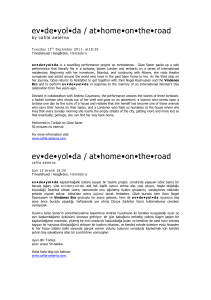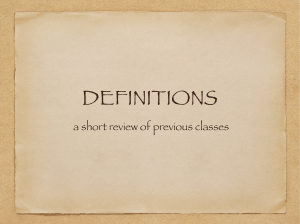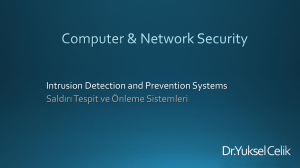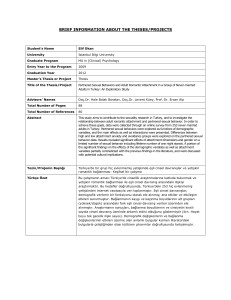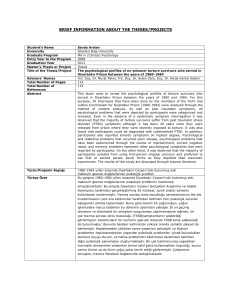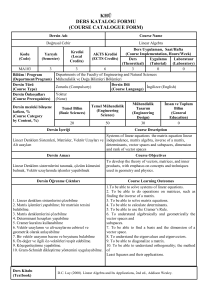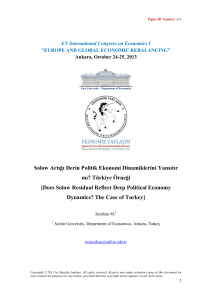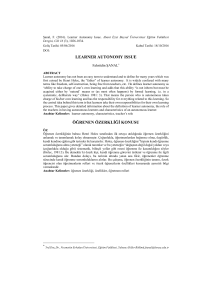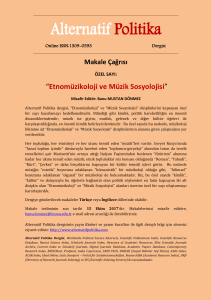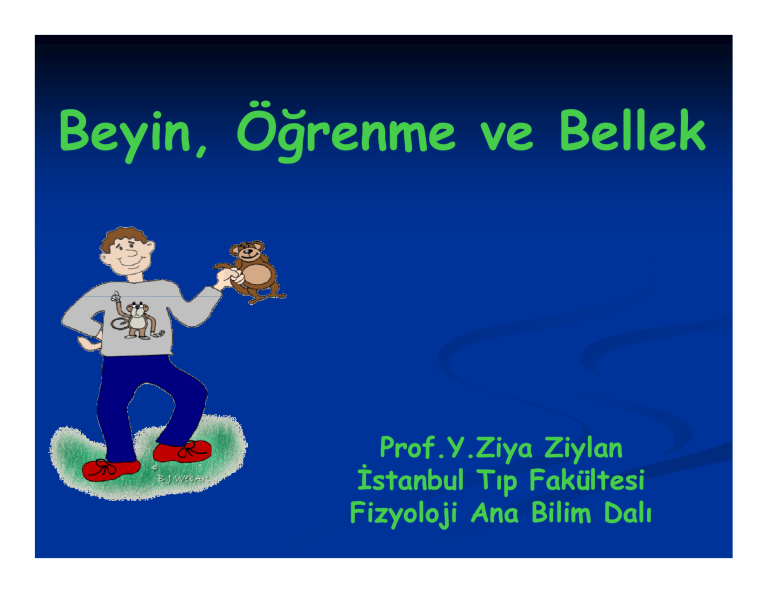
Beyin, Öğrenme ve Bellek
Prof.Y.Ziya Ziylan
İstanbul Tıp Fakültesi
Fizyoloji Ana Bilim Dalı
Öğrenmenin tanımlanması
“A process or procedure by which, in the
light of experience, either:
A: changes behaviour
Or
B: at least acquires the potential for future
change.”
Learning is potentially reversible?
Öğrenme İşlevleri
Davranışsal
Habitüasyon, Sensitizasyon
Klasik Koşullan
Klasik
Koşullanma
Operant Koşullanma
Habituation
Very basic learning
A stimulus is repeatedly presented
E.g., a light or a tone
With no significant consequence
Result: Initial response to the stimuli
diminishes with continued presentation
E.g., 1st car alarm goes off – everyone rushes
to help - Car alarms go off every day – no one
rushes anymore - habituation
Basit Öğrenme
Habituasyon ve Koşullanma
(klasik ve operant)
Klasik
lasik Koşullanm
oşullanma
Silinme
Spontane iyileşme
Uyarının genelleştirilmesi nedenleriyle kaybedilir
Ayırt ed
edebilme eğiti
eğitim
mini gerektirir
Her şeye rağmen klasik koşullanma öğrenmeyi içerir ve
bu öğrenmede olylar arasındaki ilişki önem taşır.
Koşullanma
(Çervesel olaylarla davranış cevapları arasındaki
ilişkileri öğrenme işlemleri)
Pavlov’s Dogs
Sindirim refleksleri ve
salya salgılanması
Ps
Psişik
işik salgılama
Operant (Enstrümental)
Koşullanma
Reinforcement—the occurrence of
a stimulus following a response
that increases the likelihood of the
response being repeated
Positive Reinforcers increase behavior
Negative Reinforcers increase behavior
Instrumental conditioning
Sometimes termed “operant
“operant
conditioning””
conditioning
A form of associative learning where the
animal is ‘instrumental
instrumental’’ in what occurs
For example:
In a simple maze a rat is rewarded by
turning left with food and this increases
the chances the animal will turn left
subsequently entering the maze
Instrumental conditioning
100 trials later!
Cezalandırma
Bir davranış sonrası bir uyaran verilmesi
Presentation of a stimulus following a behavior that acts
to decrease the likelihood that the behavior will be
repeated
Must be consistent to be effective.
Çoçuklar için uygun değildir
Cezalandırmanın olumsuzlukları
Does not teach or promote alternative, acceptable behavior
İstenmeyen sonuçların ortaya çıkmasına neden olabilir (ör.,
düşmalık, pasiflik, korku )
Geçici olma olasılığı yüksektir
Agression gelişimine neden olabilir
Cezalandırmaya alternatif
İyi davranışları güçlendirme, kötü davranışları önemsememe
İyi Management Te
Tekniği
kniği
Po
Pozziti
itiff destek aynı zamanda iyi hissetmeyi sağlar
Reinforcement Schedules
Continuous—every correct response is
Continuous—
reinforced; good way to get a low frequency
behavior to occur
Partial—only some correct responses are
Partial—
reinforced; good way to make a behavior
resistant to extinction
Davranışsal (Gözlemsel) öğrenme
Gözlenen aktiviteleri anlama çabasıdır, gözlem
sırasında gözlenebilen uyaranlar ve bunlara
verilen cevaplar önemlidir
Bu tip öğrenmede kişi öğrenme emirlerine yanıt
verme zorunda değildir
Öğrenme; Kişilik Gelişimi
Temel öğrenme
Koşullanmayı içerir
When junior does
something that mom or
dad does not approve of he may be punished in
some fashion
Likewise, he may be
rewarded when he does
something right
This may lead to behavioral
change
So
Sosyal
syal öğrenme:
öğrenme:
vicarious learning
Noticing and recalling the
kinds of environmental
feedback and social
conditioning other people
get
and imitation
It can be either conscious,
or unconscious.
Duygular ve Öğrenme
Korku yok
Bang!
Korku
Sıçan ve benzer canlılardan korkma
Food, fears, & phobias
Humans (and other animals) are very
quick to learn certain associations
Taste aversion learning – the Garcia
effect (Garcia, 1989)
Specific to taste in rats – difficult to pair
visual or auditory stimulus
Can often be learned in a single trial
Difficult to unlearn
Food, fears, & phobias
Humans also appear to
be preprogrammed to
learn certain fears
quickly (Marks & Nesse,
94)
We are often afraid of
heights, snakes or small
scuttly things as these
were dangerous in
ancestral times
Öğrenmenin Kazanımları
Canlıların büyük bir çoğunluğu için
çevreoldukça koplikedir Bu çevrede her değişime
uyum göstermek uygun cevabı gerektirir.
Öğrenme ile bu sağlanır (Ortama Uyum)
Öğrenme canlılara Davranışsal fle
fleksi
ksibilit
bilitee
kazandırır
Ör., Neleri yiyip neleri yiyemeyeceğini öğrenir
Ancak öğrenmenin daima adaptif olduğunu
düşünmemek gerekir, yanlışlıklar da öğrenilir
Dikkat!!
Dikkat
Dikkatinizi buna
vermelisiniz diğerine
değil !
Çok fazla info
informasyon
rmasyon
Dikkat sınırlı
olduğundan
• Çok sayıda ilgi çekici şey
bir kerede sunulursa
• Belirsizliğe
(karmaşa) yol açar
Dikkat
Üç tip dikkat vardır;
Seçici
Seçici Dikkat
Belirli informasyonlara odaklanmak ve diğerlerini
önemsememek
Ör ., şekilleri önemsemeden sadece renklere odoklanmak
Uzatılmış Dikkat
Uzun süre aynı informasyonlara odaklanmak
Ör
Ör.,
., bir radar ekranına saatlaerce kilitlenmek
Bölünmüş Dikkat
Aynı anda bir şeyden daha fazlasına
eş zamanlı olarak odaklanmak
Ör
Ör.,
., bir seminerde hem dinleyip
hemde kağıtta bir şeyler çizmek
/ öğle yemeğinde ne olduğunu
düşünmek
Dikkat
“Subjective experience of identical stimulus being
perceived at different times with more or less clarity”
Attention can refer to any sense
Vision, audition etc.
Can also refer to internal processing
Such as attempts to concentrate on particular tasks
Or intrusion of unwanted thoughts to internal
processing
Pasif
Pasi
f & Akti
Aktif
f Dikkat
Dikkati tetikleyen bazı faktörler 2
gurupta toplanabilir;
1- İnternal olarak motive edilenler ör.,
şekle değil renge odaklanmak
2- İstemsiz olarak dikkati çeken faktörler
ör., yüksek ses
Dikkat; Teoriler
Duysal kayıt
Broadbent
Filtreleme
Kısa süreli bellek
Bellek
Bellek bilginin kazanılarak depolanması ve korunması geri
çağrılarak kullanılması, olayıdır .
Öğrenme işlevi ile ilşkilidir. Bu işlev sinir sisteminde
gerçekleşir
Bellek üç işlemi içerir :
Bilginin kodlanması
Bilginin depolanması
Bilginin geri çağrılması (hatırlama)
Bellek
Dikkat işlevinde olduğu gibi çevreden aldığımız
informasyonlarn tümünü belleğe kaydetmemiz olanaklı
değildir
Etkili belek işlevi informasyonlardan çoğunu silmek
(unutmak ) ve sadece öneli olanları seçerek geri
saklamaktır
Hatırlama
Kodlanmamış ve depo edilmemiş bilgi
hatırlanamaz.
Ayrıca, gerilim yaratan bilgilerin tümü de
hatırlanmaz (ör
ör.,
., sınavlar ! )
Tekrar eden informa
informasyonlar
syonlar daha kolay
hatırlanır
İlk:
İlk: herhangi bir listedeki ilk şey daha
kolay hatırlanır
Son:: herhangi bir listedeki son şey daha
Son
kolay hatırlanır
Kısa ve Uzun Süreli Bellek
Short-term (Kısa süreli bellek):
Shortbellek):
Kapasitesi limitlidir (7+/(7+/-2)
Bellekte saklanma süresi kısadır (30 ssaniye
aniye))
Tekrarlama informasyonun bellekte daha uzun
kalmasını sağlayabilir
Bir defada en çok 9 şey saklanabilir (Çoğu kişi, bir anda
ilk 5 veya yedi seyi hatırlayabilecektir
Ör., aşağıdaki rakamları deneyiniz
7165389
Chunking
Grouping small bits of information into
larger units of information
expands working memory load
Which is easier to remember?
4 8 3 7 9 2 5 1 6
483 792 516
Working memory
?????
Implies no recollection of object location in
very young infants
Steady increase in success and no practice
effect implies maturation – not learning in the
brain
?????
İşlevsel Bellek
Kısa süreli bellek te simplistik bellek olarak
kabul edilebilir
Kısa süreli bellek pasif bir depolama değildir –
işlemler gerektirir
Merkezi devreler – işlevsel belleğin oluşumunu
gerçekleştirirler
Yaşlanma
Kodlama ve hatırlamada bozukluklar gelişebilir
Ancak bu tamamen doğru olmayabilir – bazı yaşlılar
gençlerden daha iyi bir bellekğe sahiptir !
Yaşlılar hatırlamakta gençlerden daha çok zorlanırlar
Ancak bazı faktörler bunu etkiler (ör.
ör.,, eğitim ,
motivasyon)
LongLong
-term ( uzun süreli bellek )
Oldukça büyük bir kapasiteye sahiptir ( sınırsız) (ör.,
50,000 sözcük !)
Uzun zaman korunur (yıllar
yıllar,, yüzyıllar
yüzyıllar))
Sözcükler işitildiklri şekilde değil, anlamlarına göre
saklanır
Sadece sesler değil, renkler ve kokular da bu bellekte
saklanır
E.g., remember your email address, parents phone
number etc.
Öğrenme ve Bellek tipleri
Eks
kspli
plissit / Implis
Implisit Bellek
Memory impacted by the lesion termed explicit (or
deklaratif) bellek- must be stated verbally and
requires conscious recollection (note: doesn’t work for
animals) -includes semantic (facts, knowledge) and
episodic (events, memory) memory
Not disrupted: implicit memory (procedural or nondeklaratif) - learning is demonstrated through
performance and may not be available to verbal
recollection (e.g., tying your shoelaces)
Note that implicit memory is a junk term that
includes several different forms of memory,
including most forms of classical conditioning
Declaratif
Declarati
f & nonnon-declarati
declaratif
f
Bellek
De
Dek
klarati
laratiff (Eksplisit) bellek:
Usual examples of memory:
Olay ve gerçeklerin bilinçli algılanmasını gerektirir
Dekleratif bellek, Semantik ve episodik belleği de içerir
Semantik
Semanti
k: Gerçekler
e.g., the capital of France is Paris
Episodik
Episodi
k: Kişisel deneyimlerden belirli kısımlarını içerir
e.g., the memory of visiting Paris
Non--dek
Non
deklarati
laratiff (veya pro
proccedural)bellek
edural)bellek::
Çeşitli yeteneklerin toplamını yansıtır, hatırlanması için
bilinçlilik gerekmez
Beceri, alışkanlıklar ,klasik koşullanma ve non assosiyatif
öğrenmeyi içerir
Bisiklete binme , Klasik koşullanma
Sensory Memory
Sensory memory forms
automatically, without
attention or
interpretation
Attention is needed to
transfer information to
working memory
Sensory
Input
Sensory
Memory
Sensory Memory
Sensory
Input
Sensory
Memory
Function—holds
Function—
information long enough
to be processed for basic
physical characteristics
Capacity—
Capacity
—large
can hold many items at once
Duration—very brief
Duration—
retention of images
.3 sec for visual info
2 sec for auditory info
Bellek Basamakları
Üç tipte depolan
depolanmış bellek fonksiyonel olarak,
kapasite olarak ve saklandığı sü
süre ola
olarak
birbirlerinden farklıdır
Devamlı tekrar
Duysal
Input
Duysal
Bellek
Dikkat
Kodlama
Uzun süreli
İşlevsel /
Bellek
Kısa süreli
Bellek
Hatırlamal
Long--Term Memory
Long
Encoding—process that controls movement from
Encoding—
working to longlong-term memory store
Retrieval—
Retrieval
—process that controls flow of
information from longlong-term to working memory
store
Maintenance Rehearsal
Sensory
Input
Sensory
Memory
Attention
Encoding
Long-term
Working or
memory
Short-term
Memory Retrieval
İşlevsel (Working
(Working)) Bellek
devresi – handles
seslendiren sözcükler
Prim
Primer
er akustik depo – Genel
(tüm) sesler
Vi
Vizio
zio--spa
spasyal
syal sketchpad Görme
Arti
Artikülasyon
külasyon
Baddeley & Hitch’s model
Merkezi devreler
Dikkat sistemi, limitli
kapasite, modaliteden
bağımsız
Artiküler devre
Vizo-spasyal sketchpad
Verbal rehearsal sistem,
zamana bağlı kapasite,
“iç ses”
Visual rehearsal sistem,
limited capacity,
“innergöz”
Primer akustik depo
Sese bağımlı sistem, limitli
kapasite, “inner kulak”
Neleri Bilmelisiniz...
Like attention memory is limited
Primacy & recency – things told to you 1st and
last are best remembered
Memory can be split between short & longlongterm
Baddeley & Hitch’s model of working (short(shortterm) memory
Types of amnesia and distribution of memory
throughout the brain
Düşünce
Cognition—mental activities involved in
Cognition—
acquiring, retaining, and using knowledge
Thinking—
Thinking
—manipulation of mental
representations to draw inferences and
conclusions
Mental image—
image—representation of objects
or events that are not present
Benzerlik ve farklılıklar
Each individual is unique
And yet each individual shares some commonalities
with others
Humans communicate with symbolic language
Kişisel Farklılıklar ve Öğrenme
Universal
traits are calibrated by
environmental influences
E.g.,
humans learn a diversity of
languages
but a language organ may have
evolved in all humans (Pinker |&
Bloom, 1990)
Amnezi
(Greek for ‘forgetfulness’)
“yeni informasyonların öğrenilemesinde veya depolanmış bilginin
kullanıllama yeteneğindeki patolojilerden kaynaklanan durumdur ”
Retrograde amnesia
Result of brain injury
Cannot
Can
not remember what happens before injury (not everything forgotten but
can be years)
But can form new memories
Anterograde amnesia
Result of brain injury
Can remember what happens before injury
But can’t form new memories
Movie: ‘Memento’
Difference
between types of amnesia is evidence for
distinction between shortshort- and longlong-term memory
Düşünce
Cognition—mental activities involved in
Cognition—
acquiring, retaining, and using knowledge
Thinking—
Thinking
—manipulation of mental
representations to draw inferences and
conclusions
Mental image—
image—representation of objects
or events that are not present
Amnezi
(Greek for ‘forgetfulness’)
“the
pathological inability to learn new information or
to retrieve information that has already been acquired”
Retrograde amnesia
Result of brain injury
Cannot
Can
not remember what happens before injury (not everything forgotten but
can be years)
But can form new memories
Anterograde amnesia
Result of brain injury
Can remember what happens before injury
But can’t form new memories
E.g, patient H.M.
Movie: ‘Memento’
Difference
between types of amnesia is evidence for
distinction between shortshort- and longlong-term memory
Herpes encephalitis
Normal
Herpes Simplex
Encephalitis
Korsakoff’s Syndrome
Sıklıkla çok ve uzun süreli
alkol alımıı nedenşyle ortaya
çıkan beyin hasarı sonucu
gözlenir
Geçmişteki pek çok olayı
hatırlamazlar
Thiamine vitamin
vitaminii eksikliği
vardır
Mamilar cisimcik küçülür
Hippo
ippok
kampus normaldir
(intact
intact))
Korsakoff’s amnesia
damage to
Medial Diencephalic thalamus
Alzheimer’s disease: plaques & tangles in memory areas
•severe and more general memory loss
(explicit + verbal implicit, e.g., priming)
•affects entorhinal ctx (1), then hpc (2), frontal (3),
parietal (3) lobes
Amnezi:
(Semanti
Semantik
k & Episodi
Episodik
k Bellek)
Hasar episodik
episodik belleği bozar ancak semanti
semantik
k bellek
değişmez (intact
(intact)) kalır
Linguisti
inguistik
k ve genel bilgi etkilenmez (resim
çizebilir,okulunu tanımlayabilir)
tanımlayabilir)
Ancak bellek kişisel deneyimleri içermez (yoksundur)
Belleğin Temeli
Bellek beyinde tek bir yapıda sınırlı olmayıp çeşitli
yapılarına dağılmıştır
Uyanık hastalardabeyin ameliyatları sırasında temporal
korteksin bazı bölümleri uyarıldığında bazı tip bellek
bilgileri ortaya çıkar
Kortikal yapının harabiyeti öğrenme ve bellek
oluşumunu bozar
Beynin belli bazı duysal impulsları alan bölümleri de
bellek oluşumuna katılır
Oks
ksipital
ipital korte
orteks
ks görsel girdilerle aktive edilir – hatta
kişiye daha önce tanıdık olan çevreyi gözünün önüne
getirmesi istendiğinde aktivasyon görülür
Oksipital lob hasarı nedeniyle renk görme yeteneğini
kaybeden hastalarda rekleri hatırlama kapasiteside
(bellek) kaybolur
Belleğin Temeli
Prefrontal cortex – role in management
of memory – possibly seat of central
executive?
Amnesia usually involves disruption of
neural connections between the frontal
lobes, the temporal lobes, the
hippocampus and the mammillary bodies
Hippocampus
The home of memory?
Probably not but...
Place cells process spatial
memory
Where something is!
Prominent in food storing
birds
More selective brain damage can produce explicit
memory problems (amnesia), also
Pt R.B.:
damage to
CA1 area of hpc
(very selective
Neuroanatomy
• The hippocampus is the critical
structure for explicit memory
damage only to CA1
• Disruption of hippocampal-circuitry can
give a similar deficit (dorsomedial thamalus)
• The greater the disruption to surrounding cortex the
more severe the amnesia
• Anterograde and retrograde amnesia usually
correlated
Amnezi
Amne
zi
Kısmi veya tam Bellek kayıpları,, soklar, psikolojik
bozukluklar beyin hasarları veya değişik hastalıklar
sonucu ortaya çıkar. Bunun nedenleri, organik veya
psikolojik olabilir
Organik Nedenler, shock, beyin hasarları, ve hastalıklardır
• hypoxic episode, herpes encephalitis
• epilepsy, Alzheimer’s disease
Psikolojik Nedenler, psikolojik travmalardır
• dissociative disorders
• psychogenic fugue
• multiple personality disorder
Amnezi
Amne
zi
Amnezi global veya material-specific olabilir
Global amnezide, bellekteki tüm informasyonlar
etkilenir
Material-specific amnezide , belirli bilgiler silinir (ör.,
yüzler)
Ayrıca, Amnezi anterograde veya retrograde olabilir.
Anterograde amnesia inability to learn anything new since
the time of the trauma (usually organic)
Retrograde amnesia loss of memory for events prior to
the time of the trauma (psychogenic or organic)
Diğer Amne
Amnez
zi Tipleri
Unilateral hippocampal hasar
results in material-specific deficits
left = words, names, etc.
right = faces, objects, etc.
Korsakoff’s psikozu
results in similar amnesia plus confabulation
Frontal lobharabiyeti STM, working memory,
temporal order, confabulation
Elektrokonvulziv Tedavi (ECT,ECS)
False memory
Memory is affect by cognition
Famous examples of child abuse
‘remembered’ from childhood under
hypnosis
In fact no such events happened
‘Memory’ created internally
Context & memory
Internal
and external cues can aid
memory
We
remember things better if we
are in the same state/place as we
were when we learned something
bilateral medial temporal lobe removal
Neleri bilmelisiniz?
Limbic system processes emotions
Amygdala important
Processing of different emotions can be identified in
the brain
2 hemispheres process +ive and –ive emotion
differently
Emotion effects cognition
Mood & Memory
Mood state dependent memory
Learning occurs in 1 mood state (happy/sad)
Then asked to recall in same or different mood state
Recall better when in same mood
Emotion & memory
Emotionally
arousing stories are
better remembered than neutral
stories (Cahill et al., 1994)
Amygdala
implicated
Adrenalin
can improve memory
retention
Toates: p293
Öğrenme ve Belleğin Nöral
Temelleri
Sinapsların Güçlendirilmesi
Synapses used
often are
strengthened (A)
Those not used
are weakened
and can become
ineffective (B)
Used lots
A
B
Not Used
Several parallel disruptions of LTP and
memory
• NMDA receptors by pharmacology or genetics
• PKA, PKC, CREB, CamKIIa, etc.
• Several instances where LTP is disrupted and
learning is not, or vice-versa
• Often depends on the protocol used to test LTP or
memory
• What neural system the memory depends on
• What stimulation protocol is used
• Still a compelling relationship between LTP and
memory
The NMDA-type glutamate receptor is
essential for LTP
Normal synaptic transmission
(depolarization) is through the AMPA-type
glutamate receptor by Na+
NMDA receptors have an associative
property:
require strong depolarization with
activity at synapse before they allow Ca++
to come in
LTP öğrenmeyi nasıl gerçekleştirir?
Footshock
Korku
Tone
LTP basolateral amygdalada
Korku koşullandırmsında etkili olur
Ko
Konsolida
nsolidasyon
syon
Mole
Moleküler
küler
Dakikalardan saatlere kadar sürer
Sistemler
stemler
aracılığıyla
Haftalardan yıllara kadarzaman alır
Explicit or Implicit learning?
Food, fears, & phobias
Humans also appear
to be preprogrammed
to learn certain fears
quickly (Marks &
Nesse, 94)
We are often afraid of
heights, snakes or
small scuttly things as
these were dangerous
in ancestral times
Food, fears, & phobias
We are not afraid of
plug points, skate
boards or cars
which now account
for far more deaths
and injuries
Cultural learning
Humans certainly
Primates, birds, fish?
Social learning – acquiring behaviour by
seeing another individual perform it
Cultural learning
Stimulus enhancement – attention drawn
to something in environment and
beahviour is learned by trial and error
Emulation – attention drawn and animal
figures out the purpose of the behaviour
Imitation – observer mimics what the
observed is doing
Duysal Bellek
Duysal
Input
Sensory
Memory
Divided into two types:
iconic memory–
memory–visual information
echoic memory–
memory– auditory
information
Function—
Function
—holds information long
enough to be processed for basic physical
characteristics
Capacity—
Capacity
—large
can hold many items at once
Duration—
Duration
—very brief retention of
images
.3 sec for visual info
2 sec for auditory info
Sensory Memory
Sensory memory forms
automatically, without
attention or
interpretation
Attention is needed to
transfer information to
working memory
Sensory
Input
Sensory
Memory
Sensory Memory
Visual sensory memory—
memory—brief memory of an
image or icon. Also called iconic memory
Auditory sensory memory—
memory—brief memory of
a sound or echo. Also called echoic memory
Auditory sensory memories may last a bit
longer than visual sensory memories
Short Term or Working
Memory
Sensory
Input
Sensory
Memory
Attention Working or
Short-term
Memory
Short--Term Memory
Short
Function—conscious processing of
Function—
information
where information is actively worked on
Capacity—limited (holds 7+/Capacity—
7+/-2 items)
Duration—
Duration
—brief storage (about 30 seconds)
Sensory
Input
Sensory
Memory
Attention Working or
Short-term
Memory
Chunking
Grouping small bits of information into
larger units of information
expands working memory load
Which is easier to remember?
4 8 3 7 9 2 5 1 6
483 792 516
Long--Term Memory
Long
Encoding—process that controls movement from
Encoding—
working to longlong-term memory store
Retrieval—
Retrieval
—process that controls flow of
information from longlong-term to working memory
store
Maintenance Rehearsal
Sensory
Input
Sensory
Memory
Attention
Encoding
Long-term
Working or
memory
Short-term
Memory Retrieval
Eks
kspli
plissit Bellek
Episodic information—
information—information about
events or “episodes”
Semantic information—
information—information about
facts, general knowledge, school work
Declarative or conscious memory
Memory consciously recalled or declared
Can use explicit memory to directly respond
to a question
Two subtypes of explicit memory
Episodik Bellek
Memory tied to your own personal
experiences
Examples:
What month is your birthday?
Do you like to eat caramel apples?
Q: Why are these explicit memories?
A: Because you can actively declare your
answers to these questions
Semantic Bellek
Memory
not tied to personal events
General facts and definitions about
the world
Examples:
How
many tires on a car?
What is a cloud?
What color is a banana?
İşlevsel Bellek
Memory that enables you to perform specific
learned skills or habitual responses
Examples:
Riding a bike
Using the shift stick while driving
Tying your shoe laces
Q: Why are these procedural memories implicit?
A: Don’t have to consciously remember the steps
involved in these actions to perform them
Try to explain to someone how to tie a shoelace
How are memories organized?
Hierarchical
Associations
organization
Neden Unuturu
Unuturuz?
Duysal bellek
The senses momentarily register
amazing detail
Kısa süreli bellek
A few items are both noticed
and encoded
Uzun süreli bellek
Some items are altered or lost
Uzun süreli bellekten geri çağırma
Depending on interference, retrieval
cues, moods, and motives, some
things get retrieved, some don’t
Unutma bellek
basamaklarının
hepsinde
gerçekleşebilir
Geri Çağırmada hata
Retrieval—process of accessing stored information
Retrieval—
Sometimes info IS encoded into LTM, but we can’t
retrieve it
Encoding
Short-term
memory
Long-term
memory
X
Retrieval
Retrieval failure
leads to forgetting
Encoding Specificity
Context effects—
effects—environmental cues to recall
State dependent retrieval—
retrieval—physical, internal
factors
Mood Congruence—
Congruence—factors related to mood
or emotions
Memory Distortion
Memory can be distorted as people try
to fit new info into existing schemas
Giving misleading information after an
event causes subjects to unknowingly
distort their memories to incorporate the
new misleading information
Unutma Teoriler
Kodlama hataları
Interferenss teoril
Interferen
teorileri
Motivee edilen unutma
Motiv
Yıkım
Kodlama Hatası
Informasyonlar hiçbir zaman uzun süreli bellek
Informasyonlar
bellekte
kodlanmaz
Kısa süreli
bellek
X
Encoding
Kodlama hatası
unutulmaya neden olur
Uzun süreli
bellek
Kodlama hatası
Even though you’ve seen thousands of pennies, you’ve probably
never looked at one closely to encode specific features
Hangisi gerçek?
erçek?
Interferenss
Interferen
“Memories interfering with memories”
Forgetting NOT caused by mere passage of time
Caused by one memory competing with or
replacing another memory
Two types of interference
Interferens
Retroaktif
Interferens
Proaktif
Interferens
Proactive Interference
Opposite of retroactive interference
When an OLD memory interferes with
remembering NEW information
Example: Memories of where you parked your car
on campus the past week interferes with ability find
car today
When women get married and change their name….
Motive
Motiv
e edilmiş unutma
Undesired memory is held back form
awareness
Suppression—conscious forgetting
Suppression—
Repression
Repression—
—unconscious forgetting (Freudian)


